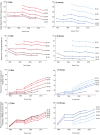Trends in prevalence, treatment and control of hypertension in 38,825 adults over 36 years in Tromsø prospective study
- PMID: 37227102
- PMCID: PMC10599076
- DOI: 10.1177/14034948221122395
Trends in prevalence, treatment and control of hypertension in 38,825 adults over 36 years in Tromsø prospective study
Abstract
Aims/background: Serial blood pressure surveys in cohort studies can inform public health policies to control blood pressure for prevention of cardiovascular diseases.
Methods: Mean levels of systolic blood pressure (SBP) were collected in six sequential surveys, involving 38,825 individuals aged 30-79 years (51% female), between 1979 and 2015 in the Tromsø Study in Norway. Mean levels of SBP, prevalence of hypertension and use of blood pressure-lowering treatment were estimated by age, sex and calendar year of survey.
Results: Age-specific mean levels of SBP in each decade of age increased by 20-25 mmHg in men and 30-35 mmHg in women and the prevalence of hypertension increased from 25% to 75% among adults aged 30-79 years. Among successive cohorts of adults aged 40-49 years at the time of the six surveys between 1979 and 2015, the mean levels of SBP declined by about 10 mmHg and the prevalence of hypertension declined from 46% to 25% in men and from 30% to 14% in women. The proportion of individuals with hypertension who were treated increased sixfold (from 7% to 42%) between 1979 and 2015, and the proportion of adults with hypertension that were successfully controlled also increased sixfold from 10% to 60% between 1979 and 2015.
Conclusions: Although this study demonstrated a halving in the age-specific prevalence of hypertension in men and women and a sixfold increase in treatment and control of hypertension, the burden of hypertension remains high among older people in Norway.
Keywords: Hypertension; cardiovascular disease; epidemiology; heart attack; serial surveys; stroke; systolic blood pressure.
Conflict of interest statement
Declaration of Conflicting InterestsThe authors declared no potential conflicts of interest with respect to the research, authorship, and/or publication of this article.
Figures


Similar articles
-
Hypertension care cascade in Chile: a serial cross-sectional study of national health surveys 2003-2010-2017.BMC Public Health. 2020 Sep 14;20(1):1397. doi: 10.1186/s12889-020-09483-x. BMC Public Health. 2020. PMID: 32928176 Free PMC article.
-
Estimating the changing burden of disease attributable to high systolic blood pressure in South Africa for 2000, 2006 and 2012.S Afr Med J. 2022 Sep 30;112(8b):571-582. doi: 10.7196/SAMJ.2022.v112i8b.16542. S Afr Med J. 2022. PMID: 36458347
-
Prognostic interactions between cardiovascular risk factors.Dan Med J. 2014 Jul;61(7):B4892. Dan Med J. 2014. PMID: 25123126 Review.
-
Trends in population blood pressure and determinant factors for population blood pressure.Dan Med J. 2017 Mar;64(3):B5353. Dan Med J. 2017. PMID: 28260600
-
Epidemiology of Hypertension in Older Adults.Clin Geriatr Med. 2024 Nov;40(4):515-528. doi: 10.1016/j.cger.2024.04.007. Epub 2024 May 28. Clin Geriatr Med. 2024. PMID: 39349028 Review.
Cited by
-
Factors Influencing Preoperative Blood Pressure Fluctuations in Patients Undergoing Elective Surgery: A Retrospective Observational Study.Int J Gen Med. 2025 Mar 19;18:1615-1622. doi: 10.2147/IJGM.S507706. eCollection 2025. Int J Gen Med. 2025. PMID: 40130073 Free PMC article.
-
Trends in hypertension and hypertension treatment in primary care in general practices in Germany between 2013 and 2022.Front Cardiovasc Med. 2024 Jun 12;11:1390902. doi: 10.3389/fcvm.2024.1390902. eCollection 2024. Front Cardiovasc Med. 2024. PMID: 38932990 Free PMC article.
-
The Association Between Mild Cognitive Impairment and Medication Non-adherence Among Elderly Patients With Chronic Diseases.Cureus. 2023 Oct 26;15(10):e47756. doi: 10.7759/cureus.47756. eCollection 2023 Oct. Cureus. 2023. PMID: 37899893 Free PMC article.
References
-
- Bonaa KH. Myocardial infarction mortality. Tidsskr Nor Laegeforen 2011;131:440–1. - PubMed
-
- Hopstock LA, Bonaa KH, Eggen AE, et al.. Longitudinal and secular trends in blood pressure among women and men in birth cohorts born between 1905 and 1977: the Tromso Study 1979 to 2008. Hypertension 2015;66:496–501. - PubMed
MeSH terms
LinkOut - more resources
Full Text Sources
Medical

